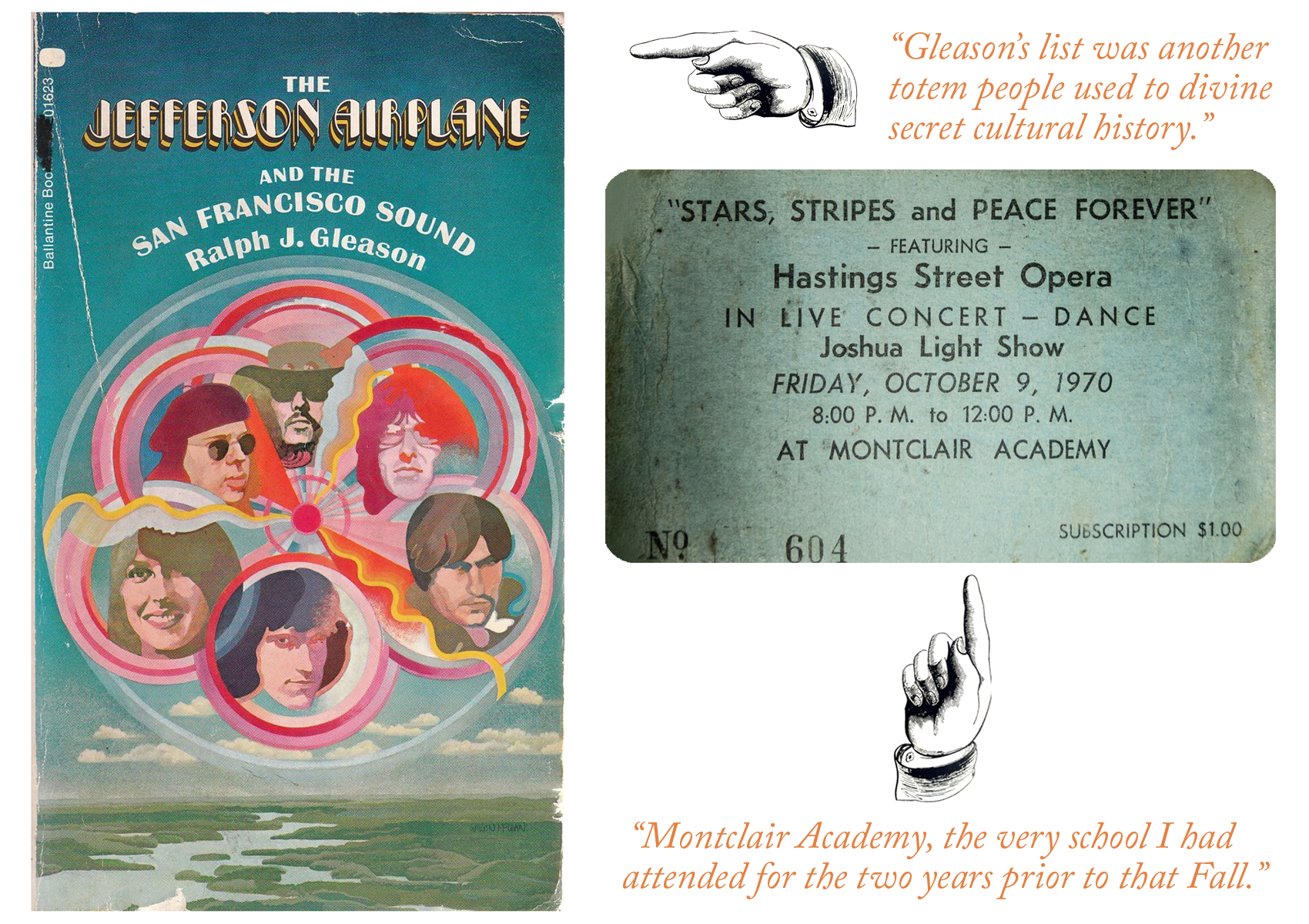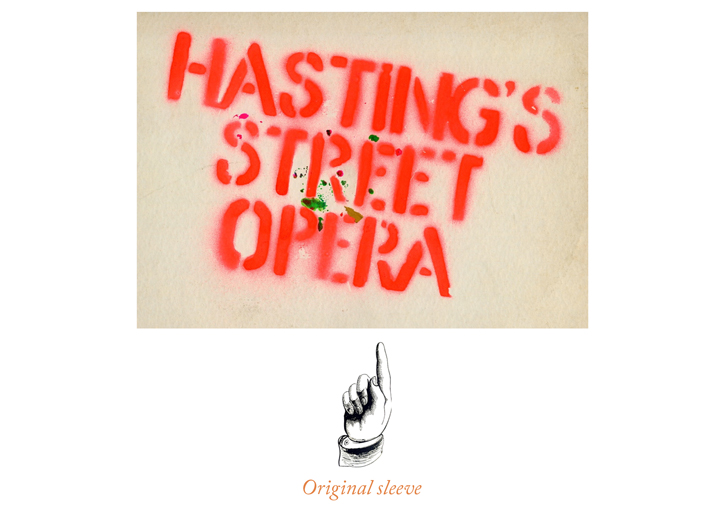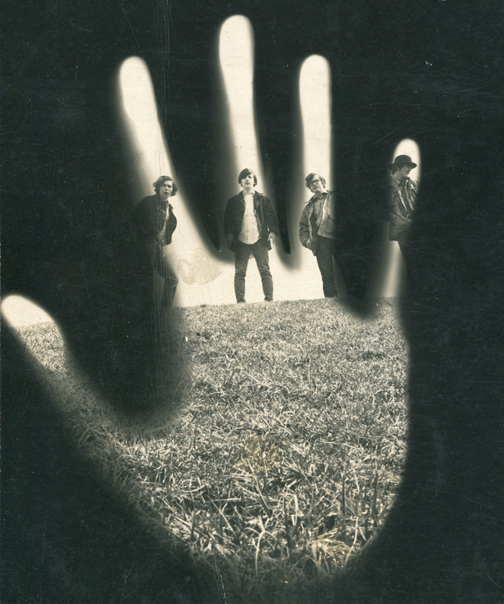CLICK HERE TO PURCHASE SLIPPERY WHEN WETIn an interesting turn of events, Out-Sider Records has just reissued, Slippery When Wet, the 1969 LP by Hasting’s Street Opera. A handful of copies of this record popped up 10-12 years ago, and were reported by dealers to be the work of a Bay Area band, who had been included in the list of obscure combos assembled by Ralph Gleason in his 1969 Ballantine paperback, Jefferson Airplane and the San Francisco Sound. In the years before the NWW list was on weirdos’ minds, Gleason’s list (which included lots of bands who never released records) was another totem people used to divine secret cultural history. A day when you could find a tape with a live track by Final Solution or the Haymarket Riot, was a very good day, indeed.
That said, Hasting’s Street Opera was more obscure than many of their brethren. Most of the Opera’s known gigs occurred in Berkeley in 1967 and ‘68, and I seem to remember discovering they had shared some local outdoor stages with Mad River and Notes from the Underground. No Bay Area underground newspaper I could access had any reports on their live sound, however, so the music on the album existed without much context.
From their name one would assume they’d be a blues band. After all they took their moniker from the 1948 single, “Hastings St. Opera” (note no apostrophe) by Detroit Count (aka Bob White.) Recorded at and released by Joe’s Record Shop on Hastings St. (then the epicenter of Detroit’s Paradise Valley district), the two-part talking blues was voiced over a barrelhouse piano, and documents a humorous walk through the then-thriving African American neighborhood. Hastings Street was subsequently razed and replaced by the Chrysler Freeway as part of a great urban renewal swindle that tried to destroy black urban America (“send ‘em back to the plantations”) in the years after World War II’s northward migrations. The song had entered white teen consciousness when it was included on the 1966 compilation, Detroit Blues - The Early 1950s, released by the Blues Classics imprint (a subsidiary of the Berkeley-based Arhoolie Records.)

But the music of Slippery When Wet was not really bluesy. The core of the band’s sound was based on the shuffling hippie stomp of Bumble Bee’s guitar, Mole’s bass, and H. Root’s drums. They were often joined by Cromagnon Man on flute, and there was a tune with Woody Carland on piano. It was also stated that “Uncle Charley” handled the one track. There were eight cuts, mostly all instrumental. Three of them were covers — Simon & Garfuck’s “Scarborough Fair,” Bobby Scott’s “A Taste of Honey,” and the Gershwins’ “Summertime.” There was also a short track, “lo-de-do,” that sounded like a little bit of a studio goof. The tune with piano had a soul jazz feel with a sort of Bobby Timmons vamp at its base and a little Tal Farlow guitar mixed in. The other three originals were instrumentals (although there were some bits of Oral Roberts evangelical sermons reprised here and there) and those had a loose, West Coast-y feel. But when the flute was puffin’ it was hard to not-think of Andy Kulberg’s work with the original Blues Project.
Their cover of “A Taste of Honey” presaged the brief period of the early ‘70s Larry Coryell spent with Herbie Mann. And certain passages of churn also recall Coryell’s earlier band with Jim Pepper, The Free Spirits. “Scarborough Fair,” meanwhile was very reminiscent of “Gold and Silver,” Quicksilver Messenger Service’s tribute to Paul Desmond’s “Take Five.” And the general feel of the playing made me certain this was a California record.
Imagine my surprise, then, to discover (via the liner notes to this reissue) that this album was actually the work of high school students from Montclair, New Jersey. And there’s a ticket stub reprinted in the notes showing them playing an event called Stars, Stripes and Peace Forever in October 1970 at Montclair Academy, the very school I had attended for the two years prior to that Fall. My visions of California were totally bogus. I could have probably gone to watch these guys rehearse after soccer practice if I’d had a mind to.
Montclair is about a dozen miles west of Manhattan, just across the Hudson River, and due to the city’s proximity (and probably some zoning laws as well) the town has never been much of a hub for nightlife. People just go across the river for that. I remember the very first of what was supposed to be a string of Monkees Nightclubs opened in nearby Caldwell in ‘67. This was going to be a venue to showcase local bands while teens drank soda. I don’t recall it lasting very long, but maybe the Opera played an audition night there. There’s also the Meadowbrook Theater in Cedar Grove. That place started off doing big band radio broadcasts back in the ‘30s, but went through various phases. I swear I saw Kraftwerk there on the ‘75 U.S. tour, but can find no record of the show actually happening. Ah well.

In the notes, the band mentions mostly playing in somebody’s barn and that sounds about right. In that period of the late ‘60s, most of the real local action was either at schools (both Montclair Academy and Montclair State University had their share) or in some truly unlikely spot, like a barn. But their gig at Montclair Academy (with the Joshua Light Show — who did the house lights at the Fillmore East) must have been boss. That October was the height of the anti-Vietnam scene in the States and the show would have immediately preceded by a National Student Moratorium to protest the war.
That the album even exists is pretty crazy. These guys all went to Montclair High, and their math teacher was a guy named Charles Faurot. In his off-hours, Faurot was a banjo player and traveled the Southeast recording various old-time music. Most of this material was issued by County Records. Presumably, when the guys from the Opera found out about this, they hounded him until he hauled out his one-track reel-to-reel and cut a session with them. Other records Faurot did that year are: Ernest East and the Pine Ridge Boys’ Old-Time Mountain Music, the More Clawhammer Banjo Songs & Tunes comp, Joe Greene’s Fiddle Album, Kenny Baker’s Portrait Of A Bluegrass Fiddler, and The Mountain Ramblers’ Mountain Dance Music from the Blue Ridge. There’s no report on what "Uncle Charlie" thought of the eventual album, but I bet he dug it.
I am just bummed out I never saw the album for sale at Valley Music, the Montclair record store I visited every week after my piano lessons. I’d like to think I would have had the fucking brains to have bought it, when I stopped in for my weekly record and copy of Go magazine. But if it was there, I sure don’t recall seeing it. Had this happened, I would have never had to concoct my whole stupid West Coast theory. And had I known they were around, I might have even gone to one of those barn gigs.
But as they say, if wishes were records, I’d have more than I already do, which would be fucked. Still, I’m pretty sure anybody who actually likes ‘60s sounds would get some kicks out of this. The actual story of the record is more interesting than the one dealers invented. Which is typical. So the next time you see a record dealer who’s not me, kick them in the shin. Just on general principle.
— Byron Coley, March 2019
